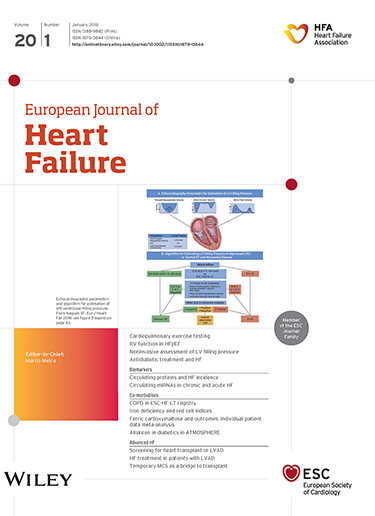Finerenone对心力衰竭患者胰岛素抵抗的影响:FINEARTS-HF试验的启示
IF 10.8
1区 医学
Q1 CARDIAC & CARDIOVASCULAR SYSTEMS
引用次数: 0
摘要
目的:估计葡萄糖处置率(eGDR)是一种简单、无创的胰岛素抵抗测量方法。在FINEARTS-HF的探索性分析中,我们评估了较低的eGDR(反映更大的胰岛素抵抗)是否与心力衰竭(HF)的不良结局相关。方法和结果eGDR在基线时使用腰围、糖化血红蛋白和高血压状态计算。根据基线eGDR(<中位数或≥中位数)评价芬尼酮的临床结局和治疗效果。在5851名(98%)具有可计算的eGDR(中位数[四分位数间距]5.1 [3.9-6.3]mg/kg/min)的参与者中,较低的eGDR与较高的蛋白尿和较差的基线hf相关健康状况相关。与eGDR≥5.1 mg/kg/min的受试者相比,eGDR <5.1 mg/kg/min的受试者心血管死亡和总心衰事件发生率高63%(校正率比[aRR] 1.63; 95%可信区间[CI] 1.41-1.87; p < 0.001)。在糖尿病患者(aRR 1.72; 95% CI 1.40-2.12)和非糖尿病患者(aRR 1.34; 95% CI 1.07-1.68; p相互作用= 0.06)中也观察到类似的结果。较低的基线eGDR还与较高的血管事件、肾脏结局、新发糖尿病和全因死亡发生率相关。芬尼酮对心血管死亡和总心衰事件(p相互作用= 0.64)以及新发糖尿病(p相互作用= 0.36)的治疗益处与基线eGDR类别无关。基线eGDR分类没有改变芬烯酮的安全性。结论:eGDR是一种有效的胰岛素抵抗指标,与心衰患者(包括非糖尿病患者)的心血管、肾脏和代谢结局广泛相关。芬尼酮降低了心血管结局和新发糖尿病的风险,与基线胰岛素抵抗无关。临床试验注册:clinicaltrials .gov NCT04435626。本文章由计算机程序翻译,如有差异,请以英文原文为准。
Finerenone according to insulin resistance in heart failure: Insights from the FINEARTS-HF trial.
AIMS
The estimated glucose disposal rate (eGDR) is a simple, non-invasive measure of insulin resistance. In this exploratory analysis of FINEARTS-HF, we evaluated whether lower eGDR, reflecting greater insulin resistance, is associated with adverse outcomes in heart failure (HF).
METHODS AND RESULTS
The eGDR was calculated at baseline using waist circumference, glycated haemoglobin, and hypertension status. Clinical outcomes and treatment effects of finerenone according to baseline eGDR (
求助全文
通过发布文献求助,成功后即可免费获取论文全文。
去求助
来源期刊

European Journal of Heart Failure
医学-心血管系统
CiteScore
27.30
自引率
11.50%
发文量
365
审稿时长
1 months
期刊介绍:
European Journal of Heart Failure is an international journal dedicated to advancing knowledge in the field of heart failure management. The journal publishes reviews and editorials aimed at improving understanding, prevention, investigation, and treatment of heart failure. It covers various disciplines such as molecular and cellular biology, pathology, physiology, electrophysiology, pharmacology, clinical sciences, social sciences, and population sciences. The journal welcomes submissions of manuscripts on basic, clinical, and population sciences, as well as original contributions on nursing, care of the elderly, primary care, health economics, and other related specialist fields. It is published monthly and has a readership that includes cardiologists, emergency room physicians, intensivists, internists, general physicians, cardiac nurses, diabetologists, epidemiologists, basic scientists focusing on cardiovascular research, and those working in rehabilitation. The journal is abstracted and indexed in various databases such as Academic Search, Embase, MEDLINE/PubMed, and Science Citation Index.
联系我们:info@booksci.cn
Book学术提供免费学术资源搜索服务,方便国内外学者检索中英文文献。致力于提供最便捷和优质的服务体验。
Copyright © 2023 布克学术 All rights reserved.
京ICP备2023020795号-1
 京公网安备 11010802042870号
京公网安备 11010802042870号
京ICP备2023020795号-1

Book学术文献互助群
群 号:604180095

 求助内容:
求助内容: 应助结果提醒方式:
应助结果提醒方式:
